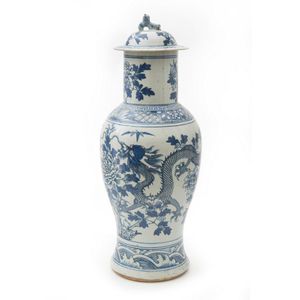Creamware Tankard and Tea Cannister with Masonic and Courting Scenes
You must be a subscriber, and be logged in to view price and dealer details.
Subscribe Now to view actual auction price for this item
When you subscribe, you have the option of setting the currency in which to display prices to $Au, $US, $NZ or Stg.
- Circa - A Latin term meaning 'about', often used in the antique trade to give an approximate date for the piece, usually considered to be five years on either side of the circa year. Thus, circa 1900 means the piece was made about 1900, probably between 1895 and 1905. The expression is sometimes abbreviated to c.1900.
- Creamware - Creamware, also known as "Queens Ware" is the
cream-coloured English earthenware developed by Josiah Wedgwood in the 1760s.
The invention of creamware was the result of experimentation in order to find a
British substitute for imported Chinese porcelain, and the cream colour was
considered a fault at the time. The lightweight fine white earthenware with a
clean rich yellowish proved ideal for tableware
and decorative items during the 18th and 19th centuries and is still produced
today.
Creamware is made from a
mixture of kaolin, feldspar, and ball clay, and is typically glazed before
firing to give it its glossy finish. It was developed by British potters as a
cheaper alternative to porcelain.
At Wedgwood, Royal patronage
boosted sales. In 1765 Queen Charlotte, the consort of King George III placed
an order for a 12 place tea set and allowed Wedgwood to use the name
"Queens Ware" for the line. In 1770 Wedgwood produced a creamware
dinner service of 952 pieces supplied to Catherine II the Great of Russia.
Other potteries such as
Doulton, Neale & Co. and Spode produced smaller quantities of creamware.
Creamware continued to be
made throughout the 19th century and later.
This item has been included into following indexes:
Visually similar items

A large Chinese blue and white covered vase Qing Dynasty, late 19th century, of 'Phoenix tail' form, decorated to the body with writhing dragons amidst peonies, between diaper and wave patterned borders, the lid surmounted by a guardian lion finial, 62 cm

Two sterling silver scent bottle cases, hallmarked Birmingham 1899 and 1901, 6.5 cm high and 8.5 cm high

Fine Japanese gold and silver wire cloisonne vase, Meiji period (1868-1912), decorated with birds on blossoming branches, unsigned but attributed to Miwa Tomisaburo. Height 25 cm

A Chinese porcelain vase, bearing panels of birds and shrubs within an elaborate yellow and green enamel border. Six character underglaze blue Guangxu mark. Height 30.5 cm
